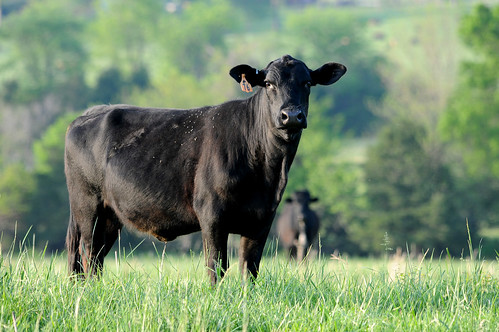Early shedding correlates to better cattle breeding performance
By Fred Miller
U of A System Division of Agriculture
May 20, 2016
Fast Facts:
- Research shows Arkansas cattle that shed winter coats early tend to show better breeding performance
- Arkansas researcher joins Missouri study on genetics of environmental adaptation in cattle
- Division of Agriculture scientist brings four years of ongoing shedding data to larger genetic study
Related website: http://blog.steakgenomics.org/2016/04/producers-invited-to-participate-in.html
(558 words)
FAYETTEVILLE, Ark. — Genetic adaptation to environment may hold the key to breeding performance in beef cattle, according to research at the University of Arkansas System Division of Agriculture.
Jeremy Powell, professor of animal science, learned that early shedding of winter coats correlated with better breeding performance. Four years of data showed cows that shed in May had higher pregnancy rates to artificial insemination and their calves had higher weights at weaning than cows that shed their coats later in the year.
His work attracted the attention of Jared Decker, assistant professor of beef genetics at the University of Missouri. Decker recently received a three-year grant from USDA’s National Institute of Food and Agriculture for a multi-institution study to find genetic adaptation to regional beef production environments.
In short, cattle that are better adapted to the climate, grass and other environmental conditions feed better, grow better and reproduce better.
“Dr. Decker saw a poster about our shedding research that one of my students presented at a conference,” Powell said. “It complemented his work on environmental adaptation.”
Powell joined Decker’s NIFA project as a co-investigator. “He really liked that we already had four years of data,” Powell said.
Building upon his earlier research, Powell is now working to identify genetic markers that are associated with early shedding.
Rather than being controlled by one or two genes, reproductive traits are controlled by large numbers of genes that interact in ways that can be difficult to understand. So Powell is looking at smaller genetic data sets.
The markers he’s looking for are genetic mutations called polymorphisms that are associated with coat shedding. Each of these mutations takes place in a single base pair of DNA and are referred to as single-nucleotide polymorphisms, or SNPs (pronounced “snips.”)
If the SNPs associated with shedding can be identified, then they can be cataloged with genetic markers related to other environmental adaptations found by Decker and other cooperating researchers.
Powell said this would provide a tool that can help cattle breeders to identify potentially high-quality breeding stock at an early age. A simple genetic test could help select female calves to include in a breeding herd.
The NIFA study also gives Powell an opportunity to tackle another health concern for beef calves.
Powell said beef producers frequently ask him about respiratory problems experienced by stocker calves. Among the problems this causes is weight loss in weaned calves.
“A lot of this takes place between weaning and 750 pounds,” Powell said. “So, it’s right in the stocker range.”
Some of these respiratory issues are caused by known viral or bacterial pathogens for which good medicines exist. But stress is also behind many such cases.
Stockers can be stressed by many causes, Powell said. They are sold and moved to new locations, spending time in trucks with limited access to water and often mixed in with calves from different herds.
When stocker calves experience respiratory problems that don’t respond well to medical therapy, Powell said, it points to a genetic foundation.
So Powell is recording white blood cell counts, an indicator of stress, to correlate with the genetic profiles being recorded for environmental adaptation — effectively piggy-backing one research project onto another.
James Koltes, a Division of Agriculture colleague, suggested the inclusion of the white cell counts in the genetic research and is collaborating with Powell on the study.
Pursuant to 7 CFR § 15.3, the University of Arkansas System Division of Agriculture offers all its Extension and Research programs and services (including employment) without regard to race, color, sex, national origin, religion, age, disability, marital or veteran status, genetic information, sexual preference, pregnancy or any other legally protected status, and is an equal opportunity institution.
# # #
Media Contact: Mary Hightower
Dir. of Communication Services
U of A Division of Agriculture
Cooperative Extension Service
(501) 671-2126
mhightower@uada.edu
Related Links
